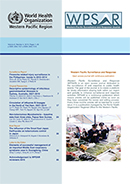Fireworks-related injury surveillance in the Philippines: trends in 2010–2014
DOI:
https://doi.org/10.5365/wpsar.2015.6.1.014Abstract
Analysis of the annual fireworks-related injury surveillance data collected by the Philippines Department of Health (DOH) in 2010–2014 was conducted to describe the profile of such injuries in the Philippines.
Surveillance data were collected from DOH’s Online National Electronic Injury Surveillance System and analysed. A case was defined as any person who had sustained injury from fireworks in any form within the 16-day surveillance period (21 December to 5 January) and had presented to any of the 50 sentinel hospitals.
Of the 4649 cases, there were 4706 fireworks-related injuries involving 5076 anatomic sites in 2010–2014. A significant decrease of cases in 2014 was observed when compared with the previous study years (P = 0.02). The number of cases peaked at public holidays. Males (80%) were more commonly injured, and children aged 5 to 14 years were primarily affected (47%). Ignition of illegal fireworks accounted for half (50%) of the injuries; most injuries (68%) occurred in street settings. The majority of injuries (57%) were sustained by fireworks igniters. The most common anatomic injury sites were hands (44%), legs (21%) and eyes (14%). Illegal fireworks were related to 100% (4/4) of the deaths and 49% (105/214) of the cases who needed amputations.
Fireworks-related injuries declined significantly in 2014. Public awareness campaigns may have contributed to reducing the injury occurrences. As illegal fireworks accounted for all deaths and more than half of the amputations, law enforcement should be directed towards preventing importing, distributing and using illegal fireworks.

